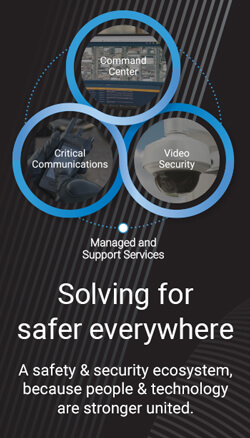With the start of a new academic calendar just on the horizon, all kinds of preparations are underway. Classrooms are being tidied and prepped for students, bus routes are being scheduled, and superintendents are working tirelessly in collaboration with their communities to plan for the upcoming year.
In the midst of a daunting to-do list, evaluating communication technology can fall to the wayside. Functioning two-way radios simply don’t cut it anymore—in the wake of frequent security and safety threats to American schools and universities, modernized solutions are becoming bare necessities for campuses nationwide.
One trailblazing difference between the radios of yesterday and the technology of today is the potential for interoperability. When emergencies arise, the ability to reach and connect beyond the confines of a school campus significantly saves time, energy, and lives.
What Is Interoperability?
At its core, interoperability is the ability of two systems to exchange or make use of information. This definition applies to communication systems in the same way: An interoperable communication system is one that can connect and exchange data with another, regardless of its type.
What makes this capability so valuable to the education industry is its contribution to emergency communication and crisis management. When a time-sensitive, life-threatening event unfolds on a school campus, first responders must be able to communicate with other agencies and prioritized points of contact to understand the entire situation.
On an internal scale, interoperability can revolutionize the functionality of a school’s existing set of communication tools. Connecting these technologies through a cloud-based service can ensure the functionality and compatibility of all systems, including radios, smartphones, cameras, and more.
Interoperable Communication Systems
MutualLink
Interoperability aims to reduce emergency response times significantly. Mere seconds can make the difference between safely diffusing a situation and endangering the lives of students and staff. Coordination is the key to protecting your campus.
MutualLink utilizes interoperability to connect superintendents with first responder agencies across diverse device or network types. Encrypted radio, video, text messaging, and file sharing provide situational awareness to all involved contacts on their preferred communication devices.
One of the unique functions of MutualLink is its panic button feature, which can simultaneously call 9-1-1, initiate a MutualLink collaboration session between the school and first responders, and notify on-site personnel—all at the push of a button. Additionally, the incorporation of an IP-based solution allows radio, voice, and video communication to connect seamlessly across a wide number of locations and with affiliated partner agencies.
FirstNet
In the event of an active threat, superintendents and supervisors need access to a direct line of communication with emergency responders. Unfortunately, when an emergency affects the entire community, it becomes nearly impossible to contact police officers, firefighters, and medics. Common channels become congested with traffic as panicked citizens and victims attempt to contact emergency services; as a result, vital messages can get lost in the mess.
A dedicated public safety broadband network can bypass any congestion and transmit messages from the school to public safety officials in real-time. This is the essence of FirstNet: A nationwide broadband network that gives first responders a direct line of communication with school superintendents and representatives.
The advanced communication and collaboration technologies of FirstNet benefit first responders as much as the communities they serve; the system allows for people in emergency situations to relay uninterrupted, real-time updates and data. In turn, responses are more efficient, safer, and less prone to the panic that uncoordinated communication can cause.
Developing an Interoperability Plan
The most effective communication methods in times of emergency require interoperability. If you’re looking to introduce interoperable systems to your current communication setup, you’ll want to develop and execute a well-thought-out plan. Ensuring the connectivity and cooperation of your preferred first responders requires a shared, practiced plan.
Planning begins with identifying your primary points of emergency contact, including police, fire, EMS, and other first responders. While the team may include front-line personnel, members should have the authority and skill set to appropriately represent their respective departments.
Once the team is identified, you can begin to assess interoperability requirements. Who must communicate? How and when? Under what situations will agencies need to work together? Additionally, you should conduct an assessment of your communication resources to identify current configurations and any gaps.
The implementation of your solution might require purchasing or upgrading existing equipment to achieve universal compatibility. Once your plan is ready to be set in motion, practice it. This step is critical: Everything must be tested ahead of time to verify both technological compatibility and the mutual understanding of all members involved.
The completion of this plan signals the dawning of a new one: a maintenance plan. This is meant to confirm the functionality of both primary and back-up technologies and devices. Consistent check-ups will ensure that your infrastructure is ready for action at a moment’s notice.
Interoperability at YOUR School: Start Now
Are you ready to experience the benefits of interoperable communication systems for yourself? Whether you’re wondering if this upgrade is right for you or concerned about budgetary restrictions, ESS is happy to help. Contact us today to get started.
Knowledge Center
- How To Prepare A Successful Grant Application
- Safe School Solutions – from Detection to Response
- JVC KENWOOD Announces Cleaning and Disinfecting Guidelines for KENWOOD Radios & Accessories
- Introducing APX Next – A Revoloution In Public Safety Communication
- 3 Ways to Improve the Safety of a Healthcare Facility
- Security Communications: Connecting Schools & Communities with Interoperability
- 5 Industries That Need Motorola Solutions
- Two-Way Radios: Healthcare Communication Tools
- Communication & Operation Solutions for the Manufacturing Industry
- Education Communication: 4 Common Challenges (and Solutions)

